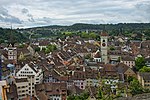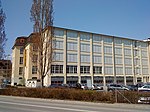Stadion Breite
Buildings and structures in the canton of SchaffhausenFC SchaffhausenFootball venues in SwitzerlandMulti-purpose stadiums in SwitzerlandSwiss sports venue stubs

Stadion Breite is a multi-purpose stadium in Schaffhausen, Switzerland. It is currently used mostly for football matches and was the home ground of FC Schaffhausen until they moved to LIPO Park Schaffhausen in 2017. The current capacity of the stadium is 7,300. The stadium has 1,028 covered seats, 262 uncovered seats and 6,010 standing places.
Excerpt from the Wikipedia article Stadion Breite (License: CC BY-SA 3.0, Authors, Images).Stadion Breite
Breitenaustrasse,
Geographical coordinates (GPS) Address Nearby Places Show on map
Geographical coordinates (GPS)
| Latitude | Longitude |
|---|---|
| N 47.703655 ° | E 8.625515 ° |
Address
Stadion Breite
Breitenaustrasse
8204 , Breite
Schaffhausen, Switzerland
Open on Google Maps









